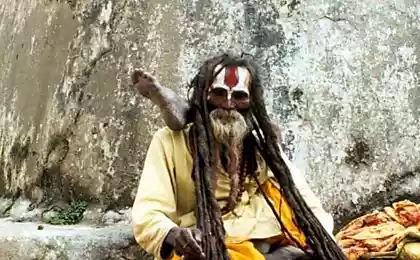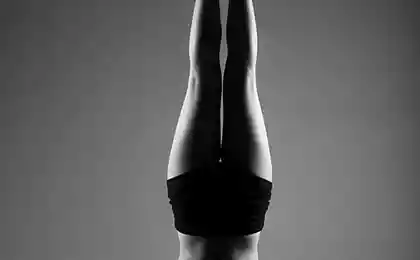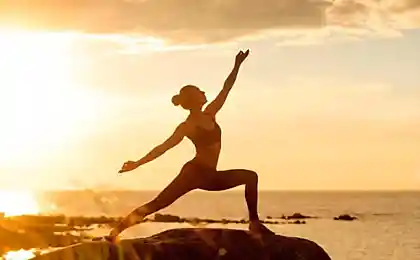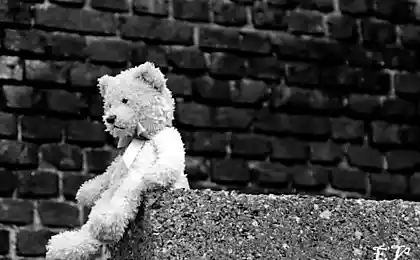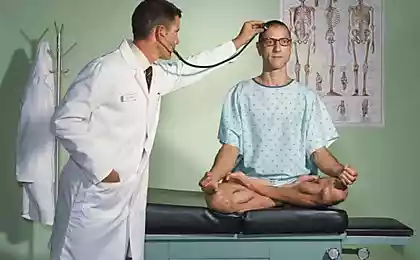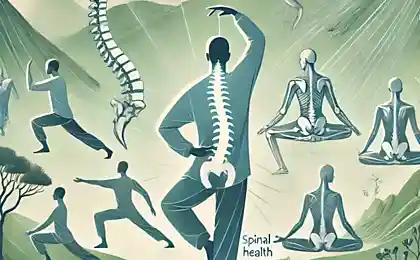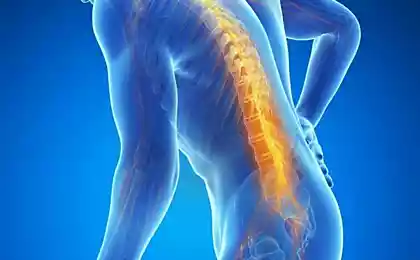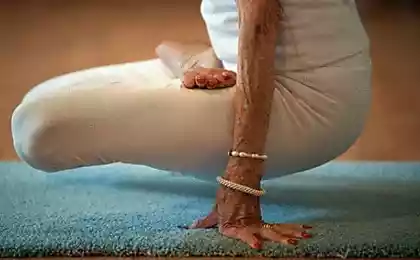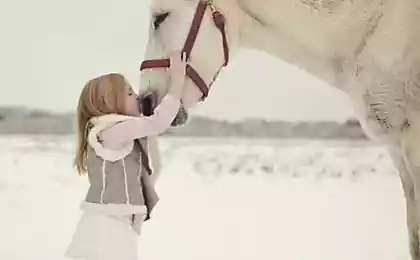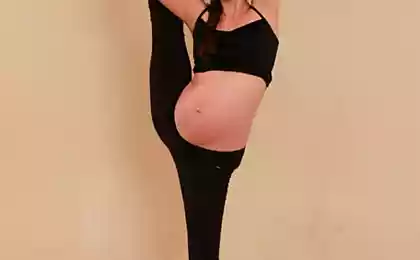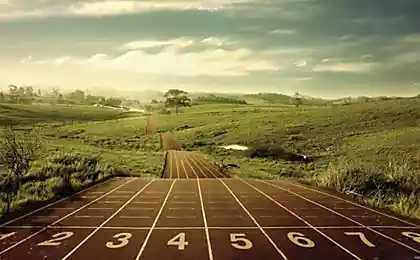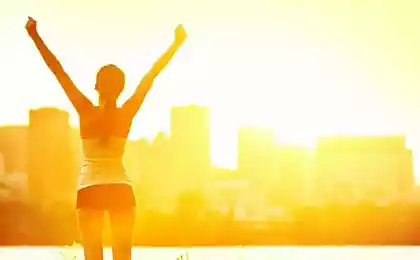1009
With this set of yoga exercises scoliosis is not terrible! Engaged, and back problems will not be.
Yoga - a great healer. Back problems now there is every second, a sedentary lifestyle is doing its job. Well, when the problem can be corrected with exercise. This complex is very positive effect on the muscles of the back. Due to its lengthening the spine and ribs are aligned, because the voltage of the back muscles away.
The main thing - do not be lazy! Asanas are described in detail, so if you are interested in these exercises, you will be able to master them, even if ever the case with yoga had.
1. Pose Cat - Cow Pose
If you are just beginning their studies, it is necessary to release the spine. Get on all fours, hands under setting shoulder and knees - under the hip joint. As you inhale, lift your head and tailbone, bending the waist. On the exhale, retract the coccyx, rounded back and let the neck. Repeat the transition from Cats cow 10 times.
2. Adho Mukha Virasana (Bow Pose Hero)
On the exhale, stretch your arms in front of him. Take a deep breath, and steered him in the back, in the area of scoliosis - where the ribs are compressed. On the exhale, Bring back the buttocks to the heels and stopped halfway. On the inhale Stretch arms and pelvis in opposite directions. Lead in the body breaths, feeling the stretch intercostal muscles, lengthen the spine and back muscles. To pull the edges of the concave side of the spine, move the weight to the opposite hand (convex) side. Keep your palms shoulder-width apart. Direct the breath into the housing and perform posture in this manner for 1 minute. Then lower on the heels of the pelvis and hands - on both sides of the body. Relax completely.

3. Tripartite traction at the bar
1. This position is necessary to carry out at the bar, hooks, balcony railing or sink. Grasp the bar, and set his hands shoulder-width apart. Without releasing the support, waste ago. Let the spine will be in a position parallel to the floor and the foot - right below the hip joint. Now, will push the heel forward and put them where before there were fingers. Pull back, buttocks taken away from the bar. Align the neck on the line of the spine, do not turn up their chin. I feel like hand-drawn through the spine is stretched along the entire length.
2. will push the foot closer to the bar and bend your knees so that your thighs are parallel to the floor turned out to be, and knees - right on his heels. Pull down the buttocks. The middle part of the back at the same time drawn down and extends to the sides of the blades.
3. The foot will advance even a few centimeters forward. Deep sit down. Pull back, feeling pulled lower spine.
4. Utthita Trikonasana (Triangle Pose pull)
The Triangle pose legs set wide apart, and the body is tilted sideways. Because scoliosis traction right and left uneven (4a - wrong version). Pulling in the direction from which the spine concave, emphasis should be placed on extending it, not allowing the ribs protrude from the opposite side. To do this, use a variation of the chair (4b - the correct version). Pulling in the direction where the spine convex to focus on twisting, aligning the right and left sides.
Suppose you have a right-sided thoracic scoliosis. Leaning to the left, you have to lengthen the spine. Put the foot for a distance of 120 cm. Unfold the left foot out at a right angle and the right inside the wrap by 45 °. Reach the body to the left, bending in the groin area. The hands in this case - are extended laterally. Put your left hand on the back of a chair - so you will be able to spread the ribs to the area of the concave side of the spine. Pull the right-hand edges inward toward the spine so that the two halves of the body are parallel to the floor. Notice how in this case the ribs in the compressed portion on the opposite side to straighten. In order to secure stability, push the outer edge of the right heel against the wall. If you are engaged in a class in which there is a rope wall, you can braid a right thigh - a great variation in the lumbar scoliosis in which resistance arises effortlessly. Pulling in the opposite direction, it is necessary to reduce the bulge in the back (option 4c). Press the outer edge of the left heel to the wall or use a rope around his left thigh. Extends from the hip. Put your right hand on the leg and the base of his left hand to push the sacrum. On the inhale Put the base of the right scapula down, taking her by the ears, and retract inwards, thus revealing the chest. On the exhale to twist from the navel, taking his left elbow back, lining the shoulders on the same line.

5. Virabhadrasana I (Hero Pose I)
In this position, not only strengthens the legs and lumbar muscles. When scoliosis posture convenient to carry in the doorway, leaning against the jamb - so you'll be able to align the body and pelvis. Stand in the doorway, so that the rear legs groin pressed against the doorframe. The heel of the front leg is in front, 60 cm from the opening. Press the inner thigh to the jamb. Fingers behind the rear feet are 60 cm from the pelvis. Align the hips parallel to each other, direct your tailbone toward the floor. On the inhale Stretch your arms above your head. Tyanis up from the top of the back, extending ribs and spine, removing them from the pelvis. On the exhale, bend the right leg at the knee at a right angle - so that the thigh is parallel to the floor and perpendicular to the lower leg. This right knee should be positioned directly over the right heel. The left leg is completely unbent, left heel drops to the floor. Pulling up the spine, at the same time push the back leg to the floor. If you can not lower the heel on the floor, put a support under it - a brick or a sandbag. Pressing your heel down and pushing it back, you turn to the work of the deep psoas.
inversions
Even with a healthy spine gravity compresses the spinal discs, and in some cases can lead to a hernia, or a pinched nerve. With scoliosis, this problem is most pronounced. The man constantly feels uneven gravity. Inverted postures free the body, they can be aligned without the usual distortions, which brings to the force of gravity position. Inverted postures also strengthen arms and back, improve blood circulation spine, brain and internal organs. They promote lymph circulation, and venous outflow.
6. Ardha Adho Mukha Vrikshasana (half Handstand)
Handstand - one of the first inverted poses that learn in yoga class. It strengthens the hands along the entire length, creating the basis for the headstand. Pulling up into a handstand, you learn to lengthen the spine against the force of gravity - and this is particularly important for scoliosis. If you are not familiar with the full rack, and is not yet ready to master it, try Ardha Adho Mukha Vrikshasanu - it will strengthen the body and inspire confidence. To warm up, perform 6a pose - Adho Mukha Shvanasanu (Dog muzzle down position), pressing the heel against the wall. Raise your right leg and pull the heel away, clutching a pillow under your fingers against the wall. Put your right foot down and lift the left. This work strengthens the upper back, which is often impaired in scoliosis. She also teaches uniformly lengthen both sides of the body. Relax in the pose of the Child. Return to Adho Mukha Shvanasane. Then lift both feet on the wall in half handstand - 6b. Arrange the width of the hips, parallel to each other. Stops should be aligned with the hip joints, not higher, and hand and body - are aligned along the entire length. Vigorously push the heel against the wall. Spread blades, leading them away from each other and from the ears. Push your palms on the floor, pull your elbows. If it is difficult, it takes advantage of the belt, tying them to the hands of land just above the elbows.

7. Salamba Sarvangasana (shoulder stand)
Stand on the shoulders gets rid of chronic tension in the neck and shoulders, which is so prevalent in scoliosis. If you are a beginner, use additional materials to expand the chest and not to shift weight on the neck and shoulders. Start with variations of the chair, roller and the wall - 7a. Put the chair back against the wall at a distance of about 30 cm. Put on the seat pad and a blanket. Perekin another blanket over the back. Put it on the floor in front of a chair cushion. Sit on a chair facing the wall and slowly leans back, coming into the pose. Lower your shoulders to roll, and a head - on the floor. Grasp the rear legs of the chair and raise your legs, pressing the foot against the wall. Relax your eyes, sending a glance at the chest. Is in position for 5-10 minutes. To exit the asana slowly slide down from the chair and lower your buttocks to the floor.
As the development of posture variation go on to the wall without a chair - 7b. Put the four folded blanket on the floor against a wall, lie to them, bringing the buttocks to the wall. Arrange the shoulders on the edge of blankets, lift legs up and push them to the wall. Bend your knees, lift the buttocks and move the weight on his shoulders. Clasped his fingers into the lock, but do not bend your elbows. Unfold shoulders. Put your hands on your back and supporting herself, pull up. Alternately straighten the legs (with the time you will be able to straighten them simultaneously). Balancers. If you are tired, put his feet on the wall, continuing to pull them. Accomplish first position for 1 min., Gradually increasing the residence time of 5-10 minutes. To exit the pose, put back on the blanket, and continuing to push the heel is lowered until the tailbone is not pressed against the wall.
As the development of these asanas can try Pinch Mayurasanu (balance on the forearms). As soon as the arms and back will become stronger, you can proceed to Salamba Shirshasana (headstand).
backbends
For me personally, backbends proved most useful class of item. They not only strengthen your back, but also relieved her tension. Thanks to them, the body has become freer and more mobile, particularly with the "convex" right side.
8. Passive deflection on the roller
When scoliosis often have muscle cramps. Although deflections while providing substantial assistance, they should be done gently, without effort. To open, you need to learn to relax the muscles of the back. Passive deflections strongly contribute to this.
Fold the dense blanket roll or try roller. Lay on the support so that the blades were on the edge, and the head and shoulders - on the floor. Stretch your legs, pushing the heel away from you - it will not allow the lower back compression. Raise your sternum. Lower your chin to your chest and lengthen the back of the neck. Hold out your hands behind your head and possibly lower them to the floor. I feel like breathing in the chest rising and falling evenly. Direct the breaths into the housing, expanding the compressed portion of the chest, revealing it. If the convex side of the back support in pushing harder, put a small portion of the a folded towel - back should be evenly pressed against the support. This is a passive bending can be performed sveshivayas with the edge of the bed.

9. Shalabhasana (Locust Pose)
Shalabhasana is essential for scoliosis, as this posture strengthens the erector spinae muscles and back of the thighs, which provides the necessary support for the spinal column in backbends. Lie down on your stomach and stretch your arms to the sides at shoulder level. On the exhale, tear off the floor head and chest. Do not relax your buttocks and thighs firmly pressed to the floor. Lengthen the arms to the side so that the blades were removed from the spine. This palm is below the level of the shoulder blades. On the exhale, close it. Repeat 3-5 times. Stretch your arms in front of you and feel your back muscles lengthen. Raise your hands and put his hand on the chair seat previously assigned to him. Again, stretch your arms and otodvinu chair away from him, lengthening the spine. Gently lift the abdomen and floating ribs. Palms pressed tightly to the seat of the chair, and hip - to the floor, lifting the spine even higher. On the exhale, close it. Perform posture 3-5. At the same time, you can raise your hands up the legs.
As the development of deflections transition to more complex postures - Dhanurasane (Luke pose) Ushtrasane (camel pose) and Urdhva Dhanurasane (inverted bow pose).
Twisting
Turns body sideways to help unwind the spine, and therefore obligatory, if you have scoliosis. Before twists necessary to lengthen the spine.
10. Bharadvadzhasana with a chair (Sage posture Bharadvaja, variation)
Sit on a chair right side and take the hands behind the back. Firmly press the foot to the floor by connecting the knees and ankles. On the inhale to lengthen the spine, exhale gently turn around from the navel, pulling the edges of the opposite side of the pelvis. To wring deeper repels his right hand on the chair back and left itself is attracted to a chair, taking the left shoulder blade toward the spine. Direct the breaths in the body while twisting. With each exhalation, curl deeper. On the exhale, slowly come out of the pose. When you right-sided thoracic scoliosis you have to focus on twisting to the right. Perform double-twisting on both sides, but the right Hold it longer.
Over time, add another twist in a sitting position - Marichiasanu (Sage posture Marichi), Ardha Matsiendrasanu (half fish pose King).
Lean forward
Lean forward Relieve deep tension in the back and shoulders. The longer you are in these positions, the deeper relaxation.
11. Janu Sirshasana (tilt your head to knee)
It sits on the edge of the folded blanket. Stretch your legs in front of him. Take the flesh of the buttocks in the side of the ischial bone. Bend your right knee and bring the heel to the right groin. Gently lower your knee to the side. Lean forward to left foot, making the movement of the hip joint. Lift your spine, put the blades, leading them from the ears, and retract them inside, opening the chest. This work helps to cope with a stoop, which is often found in people with scoliosis. To properly disclose the chest, gently push down on the chair. Put a bag of sand (or a packet with buckwheat) on the protruding side of the spine. If you can bend more deeply, put a roller or a blanket across the straight leg and lower your forehead on the stand. Perform the pose to the other side. In the same spirit can be made Pashchimottanasanu (Tilt forward from a sitting position) and other slopes. Do not defeat the materials: Use a chair, a bag of sand, cushion.
Completing practice should shavasana (Dead posture) and observing the breath.
For those suffering from scoliosis relaxation - it is quite difficult because of the clamped muscles that support the spine is uneven. BKS Iyengar advises in Shavasana underlay under the sink back is folded towel to align the body and fill the void. The position needs to feel the spine evenly expanding both sides of the chest. Move the focus on the whole body, voltage tracking sites and relaxing them. The pose is desirable to be at least 10 minutes.
As relaxing in Shavasana mind becomes calm, and it is at this moment can start healing now. Healing - this is not a physical act, it affects the deeper layers of the mind and spirit. Throughout life we face difficulties, which, like our spinal curvature can become painful noise. Learning responsibility for the healing of his back and take it carefully and sensitively, we also learn to react to the resulting emotional and physical trauma. Through yoga, we find that the curvature of the spine inherent wisdom. And strength is that we learn to live their lives sensitively, generously and evenly.
Let this article will help you become healthier, stronger body and spirit. If you liked this story - tell others about it
via takprosto cc
The main thing - do not be lazy! Asanas are described in detail, so if you are interested in these exercises, you will be able to master them, even if ever the case with yoga had.
1. Pose Cat - Cow Pose
If you are just beginning their studies, it is necessary to release the spine. Get on all fours, hands under setting shoulder and knees - under the hip joint. As you inhale, lift your head and tailbone, bending the waist. On the exhale, retract the coccyx, rounded back and let the neck. Repeat the transition from Cats cow 10 times.
2. Adho Mukha Virasana (Bow Pose Hero)
On the exhale, stretch your arms in front of him. Take a deep breath, and steered him in the back, in the area of scoliosis - where the ribs are compressed. On the exhale, Bring back the buttocks to the heels and stopped halfway. On the inhale Stretch arms and pelvis in opposite directions. Lead in the body breaths, feeling the stretch intercostal muscles, lengthen the spine and back muscles. To pull the edges of the concave side of the spine, move the weight to the opposite hand (convex) side. Keep your palms shoulder-width apart. Direct the breath into the housing and perform posture in this manner for 1 minute. Then lower on the heels of the pelvis and hands - on both sides of the body. Relax completely.

3. Tripartite traction at the bar
1. This position is necessary to carry out at the bar, hooks, balcony railing or sink. Grasp the bar, and set his hands shoulder-width apart. Without releasing the support, waste ago. Let the spine will be in a position parallel to the floor and the foot - right below the hip joint. Now, will push the heel forward and put them where before there were fingers. Pull back, buttocks taken away from the bar. Align the neck on the line of the spine, do not turn up their chin. I feel like hand-drawn through the spine is stretched along the entire length.
2. will push the foot closer to the bar and bend your knees so that your thighs are parallel to the floor turned out to be, and knees - right on his heels. Pull down the buttocks. The middle part of the back at the same time drawn down and extends to the sides of the blades.
3. The foot will advance even a few centimeters forward. Deep sit down. Pull back, feeling pulled lower spine.
4. Utthita Trikonasana (Triangle Pose pull)
The Triangle pose legs set wide apart, and the body is tilted sideways. Because scoliosis traction right and left uneven (4a - wrong version). Pulling in the direction from which the spine concave, emphasis should be placed on extending it, not allowing the ribs protrude from the opposite side. To do this, use a variation of the chair (4b - the correct version). Pulling in the direction where the spine convex to focus on twisting, aligning the right and left sides.
Suppose you have a right-sided thoracic scoliosis. Leaning to the left, you have to lengthen the spine. Put the foot for a distance of 120 cm. Unfold the left foot out at a right angle and the right inside the wrap by 45 °. Reach the body to the left, bending in the groin area. The hands in this case - are extended laterally. Put your left hand on the back of a chair - so you will be able to spread the ribs to the area of the concave side of the spine. Pull the right-hand edges inward toward the spine so that the two halves of the body are parallel to the floor. Notice how in this case the ribs in the compressed portion on the opposite side to straighten. In order to secure stability, push the outer edge of the right heel against the wall. If you are engaged in a class in which there is a rope wall, you can braid a right thigh - a great variation in the lumbar scoliosis in which resistance arises effortlessly. Pulling in the opposite direction, it is necessary to reduce the bulge in the back (option 4c). Press the outer edge of the left heel to the wall or use a rope around his left thigh. Extends from the hip. Put your right hand on the leg and the base of his left hand to push the sacrum. On the inhale Put the base of the right scapula down, taking her by the ears, and retract inwards, thus revealing the chest. On the exhale to twist from the navel, taking his left elbow back, lining the shoulders on the same line.

5. Virabhadrasana I (Hero Pose I)
In this position, not only strengthens the legs and lumbar muscles. When scoliosis posture convenient to carry in the doorway, leaning against the jamb - so you'll be able to align the body and pelvis. Stand in the doorway, so that the rear legs groin pressed against the doorframe. The heel of the front leg is in front, 60 cm from the opening. Press the inner thigh to the jamb. Fingers behind the rear feet are 60 cm from the pelvis. Align the hips parallel to each other, direct your tailbone toward the floor. On the inhale Stretch your arms above your head. Tyanis up from the top of the back, extending ribs and spine, removing them from the pelvis. On the exhale, bend the right leg at the knee at a right angle - so that the thigh is parallel to the floor and perpendicular to the lower leg. This right knee should be positioned directly over the right heel. The left leg is completely unbent, left heel drops to the floor. Pulling up the spine, at the same time push the back leg to the floor. If you can not lower the heel on the floor, put a support under it - a brick or a sandbag. Pressing your heel down and pushing it back, you turn to the work of the deep psoas.
inversions
Even with a healthy spine gravity compresses the spinal discs, and in some cases can lead to a hernia, or a pinched nerve. With scoliosis, this problem is most pronounced. The man constantly feels uneven gravity. Inverted postures free the body, they can be aligned without the usual distortions, which brings to the force of gravity position. Inverted postures also strengthen arms and back, improve blood circulation spine, brain and internal organs. They promote lymph circulation, and venous outflow.
6. Ardha Adho Mukha Vrikshasana (half Handstand)
Handstand - one of the first inverted poses that learn in yoga class. It strengthens the hands along the entire length, creating the basis for the headstand. Pulling up into a handstand, you learn to lengthen the spine against the force of gravity - and this is particularly important for scoliosis. If you are not familiar with the full rack, and is not yet ready to master it, try Ardha Adho Mukha Vrikshasanu - it will strengthen the body and inspire confidence. To warm up, perform 6a pose - Adho Mukha Shvanasanu (Dog muzzle down position), pressing the heel against the wall. Raise your right leg and pull the heel away, clutching a pillow under your fingers against the wall. Put your right foot down and lift the left. This work strengthens the upper back, which is often impaired in scoliosis. She also teaches uniformly lengthen both sides of the body. Relax in the pose of the Child. Return to Adho Mukha Shvanasane. Then lift both feet on the wall in half handstand - 6b. Arrange the width of the hips, parallel to each other. Stops should be aligned with the hip joints, not higher, and hand and body - are aligned along the entire length. Vigorously push the heel against the wall. Spread blades, leading them away from each other and from the ears. Push your palms on the floor, pull your elbows. If it is difficult, it takes advantage of the belt, tying them to the hands of land just above the elbows.

7. Salamba Sarvangasana (shoulder stand)
Stand on the shoulders gets rid of chronic tension in the neck and shoulders, which is so prevalent in scoliosis. If you are a beginner, use additional materials to expand the chest and not to shift weight on the neck and shoulders. Start with variations of the chair, roller and the wall - 7a. Put the chair back against the wall at a distance of about 30 cm. Put on the seat pad and a blanket. Perekin another blanket over the back. Put it on the floor in front of a chair cushion. Sit on a chair facing the wall and slowly leans back, coming into the pose. Lower your shoulders to roll, and a head - on the floor. Grasp the rear legs of the chair and raise your legs, pressing the foot against the wall. Relax your eyes, sending a glance at the chest. Is in position for 5-10 minutes. To exit the asana slowly slide down from the chair and lower your buttocks to the floor.
As the development of posture variation go on to the wall without a chair - 7b. Put the four folded blanket on the floor against a wall, lie to them, bringing the buttocks to the wall. Arrange the shoulders on the edge of blankets, lift legs up and push them to the wall. Bend your knees, lift the buttocks and move the weight on his shoulders. Clasped his fingers into the lock, but do not bend your elbows. Unfold shoulders. Put your hands on your back and supporting herself, pull up. Alternately straighten the legs (with the time you will be able to straighten them simultaneously). Balancers. If you are tired, put his feet on the wall, continuing to pull them. Accomplish first position for 1 min., Gradually increasing the residence time of 5-10 minutes. To exit the pose, put back on the blanket, and continuing to push the heel is lowered until the tailbone is not pressed against the wall.
As the development of these asanas can try Pinch Mayurasanu (balance on the forearms). As soon as the arms and back will become stronger, you can proceed to Salamba Shirshasana (headstand).
backbends
For me personally, backbends proved most useful class of item. They not only strengthen your back, but also relieved her tension. Thanks to them, the body has become freer and more mobile, particularly with the "convex" right side.
8. Passive deflection on the roller
When scoliosis often have muscle cramps. Although deflections while providing substantial assistance, they should be done gently, without effort. To open, you need to learn to relax the muscles of the back. Passive deflections strongly contribute to this.
Fold the dense blanket roll or try roller. Lay on the support so that the blades were on the edge, and the head and shoulders - on the floor. Stretch your legs, pushing the heel away from you - it will not allow the lower back compression. Raise your sternum. Lower your chin to your chest and lengthen the back of the neck. Hold out your hands behind your head and possibly lower them to the floor. I feel like breathing in the chest rising and falling evenly. Direct the breaths into the housing, expanding the compressed portion of the chest, revealing it. If the convex side of the back support in pushing harder, put a small portion of the a folded towel - back should be evenly pressed against the support. This is a passive bending can be performed sveshivayas with the edge of the bed.

9. Shalabhasana (Locust Pose)
Shalabhasana is essential for scoliosis, as this posture strengthens the erector spinae muscles and back of the thighs, which provides the necessary support for the spinal column in backbends. Lie down on your stomach and stretch your arms to the sides at shoulder level. On the exhale, tear off the floor head and chest. Do not relax your buttocks and thighs firmly pressed to the floor. Lengthen the arms to the side so that the blades were removed from the spine. This palm is below the level of the shoulder blades. On the exhale, close it. Repeat 3-5 times. Stretch your arms in front of you and feel your back muscles lengthen. Raise your hands and put his hand on the chair seat previously assigned to him. Again, stretch your arms and otodvinu chair away from him, lengthening the spine. Gently lift the abdomen and floating ribs. Palms pressed tightly to the seat of the chair, and hip - to the floor, lifting the spine even higher. On the exhale, close it. Perform posture 3-5. At the same time, you can raise your hands up the legs.
As the development of deflections transition to more complex postures - Dhanurasane (Luke pose) Ushtrasane (camel pose) and Urdhva Dhanurasane (inverted bow pose).
Twisting
Turns body sideways to help unwind the spine, and therefore obligatory, if you have scoliosis. Before twists necessary to lengthen the spine.
10. Bharadvadzhasana with a chair (Sage posture Bharadvaja, variation)
Sit on a chair right side and take the hands behind the back. Firmly press the foot to the floor by connecting the knees and ankles. On the inhale to lengthen the spine, exhale gently turn around from the navel, pulling the edges of the opposite side of the pelvis. To wring deeper repels his right hand on the chair back and left itself is attracted to a chair, taking the left shoulder blade toward the spine. Direct the breaths in the body while twisting. With each exhalation, curl deeper. On the exhale, slowly come out of the pose. When you right-sided thoracic scoliosis you have to focus on twisting to the right. Perform double-twisting on both sides, but the right Hold it longer.
Over time, add another twist in a sitting position - Marichiasanu (Sage posture Marichi), Ardha Matsiendrasanu (half fish pose King).
Lean forward
Lean forward Relieve deep tension in the back and shoulders. The longer you are in these positions, the deeper relaxation.
11. Janu Sirshasana (tilt your head to knee)
It sits on the edge of the folded blanket. Stretch your legs in front of him. Take the flesh of the buttocks in the side of the ischial bone. Bend your right knee and bring the heel to the right groin. Gently lower your knee to the side. Lean forward to left foot, making the movement of the hip joint. Lift your spine, put the blades, leading them from the ears, and retract them inside, opening the chest. This work helps to cope with a stoop, which is often found in people with scoliosis. To properly disclose the chest, gently push down on the chair. Put a bag of sand (or a packet with buckwheat) on the protruding side of the spine. If you can bend more deeply, put a roller or a blanket across the straight leg and lower your forehead on the stand. Perform the pose to the other side. In the same spirit can be made Pashchimottanasanu (Tilt forward from a sitting position) and other slopes. Do not defeat the materials: Use a chair, a bag of sand, cushion.
Completing practice should shavasana (Dead posture) and observing the breath.
For those suffering from scoliosis relaxation - it is quite difficult because of the clamped muscles that support the spine is uneven. BKS Iyengar advises in Shavasana underlay under the sink back is folded towel to align the body and fill the void. The position needs to feel the spine evenly expanding both sides of the chest. Move the focus on the whole body, voltage tracking sites and relaxing them. The pose is desirable to be at least 10 minutes.
As relaxing in Shavasana mind becomes calm, and it is at this moment can start healing now. Healing - this is not a physical act, it affects the deeper layers of the mind and spirit. Throughout life we face difficulties, which, like our spinal curvature can become painful noise. Learning responsibility for the healing of his back and take it carefully and sensitively, we also learn to react to the resulting emotional and physical trauma. Through yoga, we find that the curvature of the spine inherent wisdom. And strength is that we learn to live their lives sensitively, generously and evenly.
Let this article will help you become healthier, stronger body and spirit. If you liked this story - tell others about it
via takprosto cc
10 properties of the pomegranate, which you've never heard. Unbelievable, what a miracle this fruit!
10 bright ideas for tapas on skewers! Snacks that will appeal to all.

